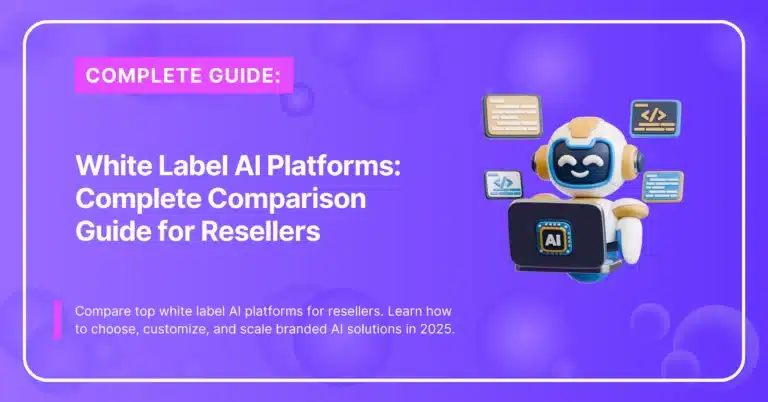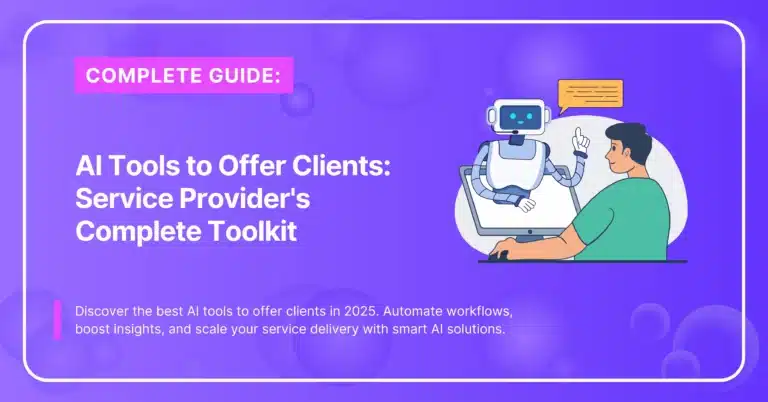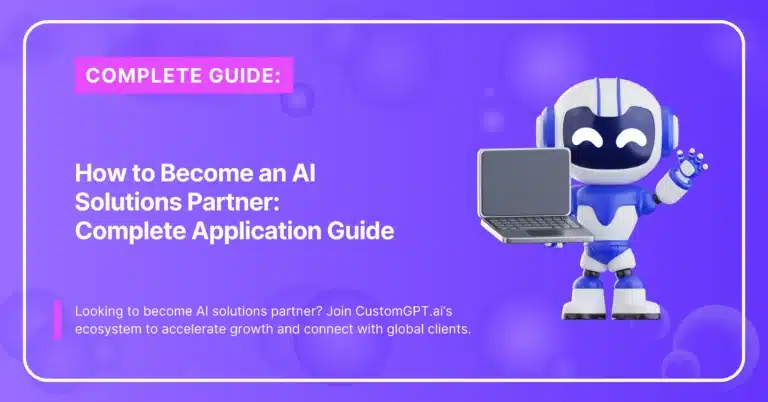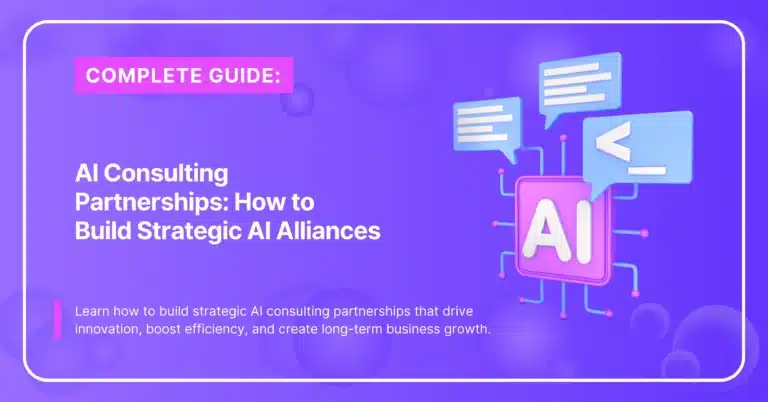Every few decades, a wave of technology redefines what it means to build a business. In the 1990s, it was the internet. In the 2000s, mobile. Today, it’s artificial intelligence.
The difference? Unlike past waves, AI isn’t just for tech giants. Cloud platforms, pre-trained models, and white-label solutions mean that entrepreneurs, startups, and small businesses now have direct access to powerful AI capabilities.

Make Money With AI
Join our Partner Programs!
Boost your reputation, drive revenue and grow your business with CustomGPT.ai.
The barrier to entry has never been lower.
This is where the real AI business opportunity lies: helping companies solve practical problems with AI—whether that’s optimizing logistics, automating customer service, or building niche AI-driven products for industries like healthcare or retail.
The question isn’t if businesses will adopt AI, but who will guide them through it. And for entrepreneurs willing to act now, the potential to create scalable, profitable AI services is enormous.
This guide will walk you through how to identify the right opportunity, validate it, build a business model, and scale—so you can turn the AI revolution into your own entrepreneurial advantage.
Understanding the AI Business Opportunity
An AI business opportunity isn’t just about building futuristic robots or creating the next ChatGPT. At its core, it means using artificial intelligence to solve real-world problems in ways that create measurable value for businesses and customers.
What makes today different is accessibility. Just a few years ago, AI solutions required massive research budgets and specialized teams.
Now, thanks to cloud platforms, open-source models, and white-label tools, even small firms can compete with industry leaders. A single entrepreneur with the right idea can launch an AI service that rivals what large organizations are offering.
Industries across the board are embracing AI:
- Healthcare: diagnostic tools, patient engagement, and workflow automation.
- Retail: personalized recommendations and demand forecasting.
- Logistics: route optimization and predictive maintenance.
- Finance: fraud detection and customer analytics.
The real opportunity lies in tailoring these capabilities to specific market needs. Instead of trying to “do AI everywhere,” the entrepreneurs who thrive will be those who focus on one niche problem, apply AI effectively, and scale from there.

Types of AI Services Businesses
One of the most exciting things about pursuing an AI business opportunity is the flexibility in how you can structure your venture. Some entrepreneurs thrive as consultants, while others prefer building scalable platforms.
There’s no single right model — what matters is aligning your business type with your skills, resources, and the needs of your target customers.
Below are the main categories of AI service businesses, along with how each creates value and where the biggest opportunities exist.
1. AI Consulting and Strategy
Many organizations know they “should” be using AI but don’t know where to start. This is where consultants come in. An AI consultant helps companies:
- Identify workflows that can be automated or optimized.
- Build an AI adoption roadmap.
- Navigate vendor selection and integration challenges.
For entrepreneurs with a mix of business knowledge and technical fluency, consulting is a powerful entry point. It requires less upfront investment than building software, yet positions you as a trusted advisor.
In many cases, consultants evolve into long-term partners, guiding clients through each stage of their AI journey.
2. Custom AI Development
Some clients need tailored solutions that off-the-shelf tools can’t provide. Custom AI development focuses on designing and deploying AI models, chatbots, or data-driven applications specific to an industry or company.
For example:
- A retail chain might want a recommendation engine tied to its loyalty program.
- A logistics firm may need an AI tool that predicts equipment breakdowns before they happen.
Custom AI development requires deeper technical expertise and usually a small team of engineers, but the payoff is high-value, long-term contracts.
3. AI Software-as-a-Service (SaaS)
This model emphasizes scalability. Instead of serving one client at a time, you build a platform that hundreds or thousands of businesses can subscribe to. Popular categories include:
- AI-powered marketing platforms.
- Predictive analytics dashboards.
- Automated customer service platforms.
The challenge here is higher upfront cost — you need to build, host, and continuously improve the product. However, once adoption grows, SaaS delivers recurring revenue and long-term stability.
4. White-Label AI Solutions
Not every entrepreneur needs to build software from scratch. With white-label solutions, you partner with an existing provider, customize their AI tools with your branding, and sell them to your target market.
This approach is ideal for entrepreneurs who:
- Want to move quickly into the market.
- Lack the resources to build complex AI tools internally.
- Prefer focusing on sales, marketing, and customer relationships.
By leveraging proven technology, you can skip the heavy R&D costs and still establish a profitable AI services business.
5. Industry-Specific AI Services
The richest opportunities often come from specialization. Instead of trying to compete in every sector, focus on one. Examples include:
- Healthcare: HIPAA-compliant AI tools for diagnostics or patient management.
- Legal: AI-driven contract review or compliance checks.
- Real Estate: Predictive analytics for pricing and market trends.
- Education: Personalized learning platforms and AI tutoring.
By going niche, you become an expert in a domain, making it easier to win trust and charge premium prices.
The best path isn’t always the biggest or most complex — it’s the one that aligns your capabilities with client demand. Whether you want to be a consultant, a SaaS founder, or a niche service provider, the landscape is wide open.
Identifying the Right AI Business Opportunity
Finding the right AI business opportunity is less about following hype and more about matching real-world problems with AI’s strengths. Many organizations are eager to adopt AI, but few know how to do it effectively.
That gap creates space for entrepreneurs to step in with focused, problem-solving services.
Look for Signs of Demand
Adoption is already widespread, but most companies still need help turning pilots into profits. According to McKinsey’s 2025 State of AI report, 78% of organizations now use AI in at least one business function, up from 72% in 2024 (McKinsey).
At the same time, a BCG study revealed that 74% of businesses have yet to generate tangible value from AI initiatives, with only a quarter moving beyond proof-of-concepts (BCG).
This means companies are investing, but many are still stuck — an ideal opening for service providers who can deliver measurable outcomes.
Use Pilots and MVPs to Test Ideas
The best way to validate an idea is through a minimum viable pilot (MVP). Instead of building a full-scale solution, test one narrow use case and measure its impact.
For example:
- A logistics firm could trial AI-driven route optimization with one fleet and track changes in fuel savings.
- A clinic might deploy a simple model predicting no-shows, then measure reductions in wasted appointment slots.
If even small pilots show clear savings or efficiency gains, you’ve got early proof that the opportunity is real.
Focus on the Real Job to Be Done
Frameworks like Jobs-to-be-Done help uncover the true needs behind customer requests. Instead of asking what tool they want, ask what job they are trying to get done.
- A clinic doesn’t just want a booking system — it wants fewer no-shows and smoother patient flow.
- A manufacturer doesn’t just want dashboards — it wants fewer delays and lower operating costs.
Positioning your AI service around solving these core jobs makes it far more attractive to decision-makers.
Check Regulatory and Data Constraints
Every opportunity must pass a compliance and feasibility test. In healthcare, HIPAA and GDPR rules apply. In finance, regulators demand explainability.
Entrepreneurs who design with privacy, compliance, and transparency from day one not only reduce legal risk but also gain trust — a critical differentiator in industries where credibility matters as much as results.
The best AI business opportunity combines three things — clear customer pain, measurable outcomes, and compliance alignment. The market is signaling strong demand, but only businesses that validate early and solve real jobs will capture lasting value.
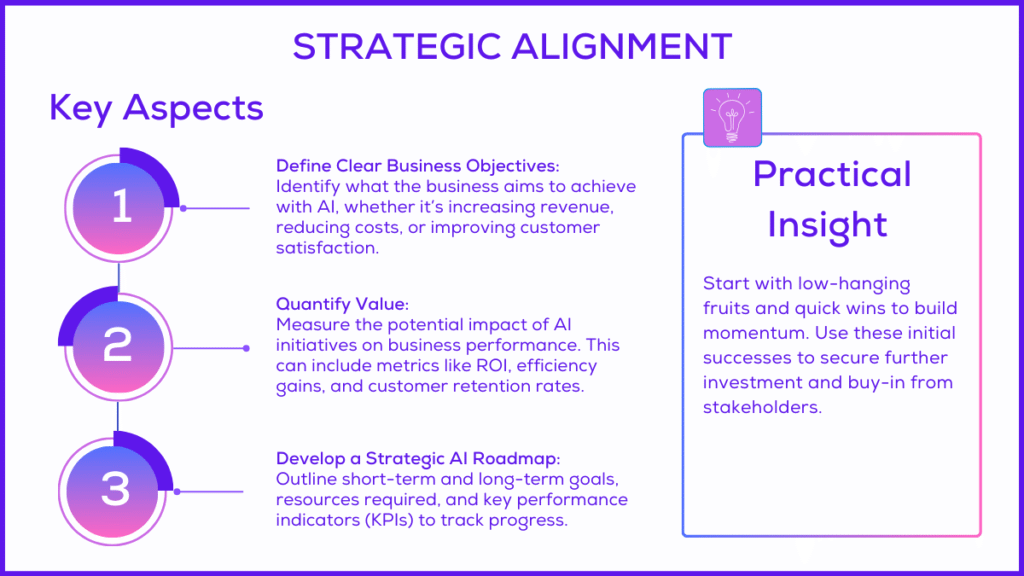
Building a Business Model Around AI
Spotting an AI business opportunity is only half the journey. Turning that opportunity into a profitable venture depends on building the right business model. The best models balance revenue predictability, client trust, and scalability.
Subscription-Based Models
One of the simplest ways to monetize AI services is through subscriptions. Clients pay a recurring fee for ongoing access to your platform or services.
- Works well for SaaS offerings like analytics dashboards or customer support bots.
- Offers predictable, recurring revenue that helps cash flow.
- However, it requires continuous updates and support to retain customers.
Usage-Based and Hybrid Pricing
Not all clients want a flat fee. Usage-based pricing charges customers based on how much they consume (e.g., per API call, per data point processed).
- Ideal for clients with fluctuating workloads.
- Aligns cost directly with value received.
- Can be combined with a base subscription in a hybrid model.
For example, AWS popularized this approach in cloud computing, and many AI providers are now following suit.
Value-Based Pricing
In some industries, clients are less concerned with features and more with outcomes. Value-based pricing ties your fees directly to the results you deliver, such as cost savings, revenue uplift, or reduced errors.
- Builds trust by sharing both risk and reward with clients.
- Works best where impact is measurable (e.g., fraud detection, predictive maintenance).
- Requires strong analytics to track performance accurately.
Choosing the Right Model
The best approach often depends on your target market and stage of growth:
- Early-stage startups may prefer subscription or hybrid models to establish stable revenue.
- Specialized providers in industries like healthcare or finance may succeed with value-based pricing, since clients prioritize measurable outcomes.
- Scalable SaaS products benefit most from hybrid pricing, ensuring both predictability and flexibility.
The right AI business model aligns how you get paid with the value you create. Subscription, usage-based, and value-based pricing each have their place, but the key is transparency and measurable impact.
Clients are far more likely to trust and stick with providers who charge in ways that reflect outcomes, not just access.
How to Start an AI Services Business
Turning an AI business opportunity into a functioning company doesn’t happen overnight. But with the right steps, you can move from idea to revenue faster than most people expect.
Here’s a proven roadmap to get started.
Step 1: Build the Right Skills and Team
AI ventures require a mix of technical and business expertise. Even solo founders need to think about the team they’ll build over time.
- Core skills: data analysis, machine learning basics, and familiarity with APIs.
- Business skills: sales, client discovery, project management.
- Cross-functional teams: combine technical experts with domain specialists (e.g., clinicians in healthcare, compliance officers in finance).
Step 2: Choose Tools and Platforms Wisely
Entrepreneurs don’t need to reinvent the wheel. Leverage platforms, frameworks, and pre-trained models to reduce costs and accelerate deployment.
- Cloud AI platforms: Google Cloud AI, AWS, Azure.
- Open-source frameworks: TensorFlow, PyTorch.
- No-code/low-code AI tools: useful for prototypes and MVPs.
Step 3: Develop a Data Strategy
AI thrives on good data. Before launching, you need a plan for sourcing, cleaning, and managing it.
- Identify the minimum data set required to validate your idea.
- Use synthetic or anonymized data where privacy is an issue.
- Set up governance early (data quality, compliance, security).
Step 4: Integrate AI into Business Operations
Technology is only part of the puzzle — the real value comes from embedding AI into client workflows.
- Use APIs to connect AI tools with existing systems.
- Start with modular deployments (microservices instead of monoliths).
- Create feedback loops for continuous learning and adaptation.
Step 5: Test, Measure, Iterate
Launch small pilots, gather client feedback, and refine before scaling.
- Track KPIs tied to client value (cost savings, time reduction, revenue impact).
- Use canary deployments — release updates to a small user group before going live at scale.
- Document lessons learned and apply them to your next iteration.
Scaling and Growing Your AI Business
Once you’ve validated an AI business opportunity and built early traction, the next challenge is scaling.
Growth isn’t just about getting more clients — it’s about creating systems, teams, and infrastructure that can handle increasing demand without breaking.
Build for Scalability from Day One
AI solutions that work for one client may not scale to dozens or hundreds. To avoid bottlenecks:
- Use modular architectures (microservices) so each component can be upgraded independently.
- Adopt cloud infrastructure for flexible scaling. Hybrid and multi-cloud setups reduce costs and improve resilience.
Expand into New Markets and Niches
The fastest-growing AI businesses don’t just add more clients — they expand into adjacent industries or geographies.
- A healthcare-focused AI startup might branch into biotech or insurance.
- A retail automation tool could adapt its solution for e-commerce logistics.
Market expansion doesn’t mean reinventing the wheel — it’s about repackaging your core capability for new audiences.
Strengthen Your Team with Cross-Functional Talent
As you grow, you’ll need more than technical staff. Successful AI firms bring together:
- Data scientists and engineers.
- Domain experts who understand the industry you serve.
- Regulatory and compliance professionals to navigate laws.
- Sales and marketing teams to drive growth.
Embed Feedback Loops for Continuous Improvement
AI isn’t a “set it and forget it” technology. Models drift, data changes, and client needs evolve. To scale sustainably:
- Collect performance data continuously.
- Set up feedback loops with clients to spot gaps.
- Retrain or fine-tune models regularly to maintain accuracy.
This iterative approach ensures your solutions stay relevant and competitive.
Diversify Revenue Streams
Scaling isn’t just about adding clients; it’s also about deepening monetization with existing ones.
- Add premium tiers or advanced features.
- Offer consulting and integration services alongside your core product.
- Provide analytics reviews or compliance audits as value-added services.
Scaling an AI business means more than growth in numbers — it’s about building flexible systems, expanding smartly into new niches, and embedding continuous learning into your operations.
With the right mix of infrastructure, talent, and feedback, today’s AI startups can grow into tomorrow’s market leaders.

Navigating Challenges: Regulation, Ethics, and Trust
Every AI business opportunity comes with challenges that go beyond technology. To succeed long-term, entrepreneurs need to anticipate and address these issues early.
Data Privacy and Compliance
Regulations like GDPR in Europe and HIPAA in the U.S. impose strict rules on how data is collected, stored, and used. Non-compliance can lead to fines of up to 4% of global revenue under GDPR (EU GDPR Info).
Building privacy-by-design — using techniques like anonymization or differential privacy — should be part of every AI workflow.
Algorithmic Bias and Fairness
AI models trained on biased data can unintentionally reinforce discrimination.
A well-known MIT study found that early commercial facial recognition systems misclassified darker-skinned women at error rates as high as 34%, compared to less than 1% for lighter-skinned men (MIT Media Lab).
Embedding fairness audits and explainability tools helps reduce these risks.
Transparency and Explainability
Clients, especially in finance and healthcare, need to understand how AI systems make decisions. Techniques like SHAP (SHapley Additive exPlanations) or LIME provide human-readable insights into model predictions.
Transparent systems not only support compliance but also build trust, which is essential for client retention.
Join the CustomGPT.ai Solution Partner Program
For many entrepreneurs, the biggest barrier to capturing an AI business opportunity isn’t demand — it’s time. Building an AI solution from scratch requires specialized teams, infrastructure, and months of R&D.
By the time your product is ready, the opportunity may have passed.
The CustomGPT.ai Solution Partner Program solves this problem by giving consultants, agencies, and service providers a way to launch AI offerings quickly, under their own brand, with enterprise-grade technology.
Why Partner with CustomGPT.ai?
- Drive New Revenue Streams: Sell or refer CustomGPT.ai solutions and earn through a rev-share model.
- Exclusive Discounts: Up to 40% off annual plans for your clients.
- Enterprise-Level Tools: Access a full-featured demo account and early releases of new features.
- Market Visibility: Be featured in the Solutions Directory and get access to qualified leads.
- Dedicated Support: Benefit from account management, co-selling opportunities, and implementation coaching.
Who Is It For?
The program is a strong fit for:
- AI consultants and solution providers.
- IT consultants and managed service providers.
- Marketing and web development agencies.
If you’re already advising clients on digital transformation, this program allows you to add AI-as-a-Service to your portfolio without the heavy lift of building models in-house.
How It Works
- Intro Call: Align with the partner team on where CustomGPT.ai fits into your current offerings.
- 15-Day Trial: Work with the team to identify client use cases and validate opportunities with coaching and guidance.
- Onboarding: Unlock partner benefits, discounted enterprise pricing, and co-selling opportunities.
The Value Proposition
- Secure and Accurate AI: Built with enterprise security and leading anti-hallucination safeguards.
- Fast Go-to-Market: No-code deployment means you can launch new AI services in weeks.
- Scalable Revenue: Earn from implementation services, recurring subscriptions, and analytics reviews.
By joining CustomGPT.ai’s global network of trusted solution providers, you can skip the steep R&D curve and start delivering value immediately. For entrepreneurs chasing today’s AI business opportunities, it’s a shortcut to revenue, credibility, and growth.

Make Money With AI
Join our Partner Programs!
Boost your reputation, drive revenue and grow your business with CustomGPT.ai.
Future Outlook: Long-Term AI Business Opportunities
The pace of AI innovation means that what feels cutting-edge today could be standard tomorrow. For entrepreneurs, the real question is not just how to capture current demand, but how to position for long-term AI business opportunities.
- Generative AI expansion: Moving beyond text and images into drug discovery, product design, and synthetic data creation.
- EdTech transformation: AI-driven platforms will personalize learning, reskill workers, and close global skill gaps.
- Automation of knowledge work: Repetitive tasks in law, finance, and administration will increasingly be handled by AI, freeing up humans for higher-value roles.
- New service niches: Demand will rise for AI consulting, integration, and risk management services as businesses adapt workflows to automation.
- Ethics and compliance edge: Regulations like the EU AI Act will make transparency, fairness, and privacy-by-design mandatory — creating opportunities for entrepreneurs who combine innovation with governance.
The future of AI isn’t limited to today’s hype. The biggest business opportunities will lie in expanding generative AI, reshaping education, automating knowledge work, and building trust through ethics and compliance.
Entrepreneurs who anticipate these shifts will be best positioned to lead in the decade ahead.
FAQ
What are the best AI business opportunities?
Some of the most promising opportunities include AI consulting, custom AI development, industry-specific solutions (healthcare, logistics, finance), and white-label AI services.
Entrepreneurs can also explore niches like AI-powered education, predictive analytics, and workflow automation.
How to start an AI services business?
– Begin by identifying a clear problem you can solve with AI.
– Build a small prototype or pilot project to validate demand.
– Choose scalable tools and platforms, set up a data strategy,
– Design a business model that aligns with client outcomes.
Partnerships (like CustomGPT.ai’s Solution Partner Program) can also help accelerate your entry into the market.
What’s the investment required for an AI business?
The cost depends on your approach. A consulting business can start with minimal investment beyond skills and marketing, while developing proprietary AI software may require significant funding for data, infrastructure, and technical staff.
Many entrepreneurs reduce costs by leveraging cloud AI platforms, open-source frameworks, or white-label solutions.
How profitable are AI businesses?
Profitability depends on your niche and model. Consulting and white-label services can generate revenue quickly with lower overhead, while SaaS products and custom AI platforms often take longer to scale but can achieve higher margins.
Long-term profitability comes from aligning pricing with measurable client value.
What skills are needed for an AI business?
A mix of technical and business skills is essential. Technical skills include machine learning basics, data analysis, and knowledge of APIs or platforms. Business skills include sales, project management, and industry expertise.
Cross-functional collaboration is key — successful teams often include both data scientists and domain specialists.
Conclusion: Turning AI Opportunities Into Action
AI is no longer a futuristic concept — it’s a business reality creating opportunities in every sector. From consulting to custom development and white-label solutions, entrepreneurs today have countless ways to capture value.
The key is to focus on solving real problems, building scalable models, and earning client trust through transparency and responsible innovation.
The window of opportunity is wide open, but it won’t stay that way forever. Businesses that act now will have the advantage of early positioning in markets where AI adoption is accelerating.
Ready to Take the Next Step?
If you’re serious about turning AI into a revenue stream, you don’t need to build everything from scratch.
The CustomGPT.ai Solution Partner Program helps consultants, agencies, and service providers launch branded AI offerings quickly — with enterprise-grade tools, partner support, and scalable revenue models.



